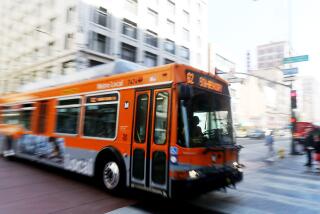A new way to capture taggers, other vandals
- Share via
LAPD Senior Lead Officer Gabriel Ahedo believes that the city’s installation of lunch-box-sized security cameras over the last six years has discouraged graffiti and illegal dumping.
One location, Cohasset Street and Radford Avenue in North Hollywood, saw a sharp decrease in graffiti thanks to the camera, which plays a recorded warning -- “Stop! It is illegal to vandalize this area. . . . Leave now” -- in addition to taking photographs triggered by a motion detector, Ahedo said.
“It’s made the area a lot safer and seems to deter taggers,” he said.
City officials eager to show their support for the cameras and the ongoing need to find ways to fight graffiti gathered in North Hollywood on Wednesday to mark the installation of upgraded cameras and to promote the use of newer, more sophisticated cameras able to capture a quality picture of a license plate from 100 feet away in complete darkness.
Officials said the cameras may help avoid sometimes dangerous confrontations related to graffiti. Last month, two women, one in Pico Rivera and another in Hesperia, were shot to death when they confronted alleged taggers in unrelated cases.
In Los Angeles, cleanup crews removed 27 million square feet of graffiti in 2006, up from 21 million square feet in 2004, according to the most recent data from the Los Angeles Police Department. Police contend that a rise in graffiti correlates with a rise in gang-related crime, which police said has risen 15% this year in the San Fernando Valley compared with the same time period in 2006.
Although police decide where to place the cameras, the Department of Public Works’ Office of Community Beautification is in charge of maintaining the devices, said Paul Racs, director of the city’s beautification office. City crews are expected to gradually reinstall all 65 cameras the city owns by late December after the devices are converted from batteries to solar power.
The camera, called the Flashcam-530, is made by Q-Star Technologies of Chatsworth and features a modified 35-millimeter camera triggered by a motion detector. When activated, the unit takes photographs that are forwarded by public works to police, and play a recorded announcement.
The complete warning, in a clear, male voice, goes as follows: “Stop! It is illegal to vandalize this area. Your photo has just been taken and we will use this photograph to prosecute you. Leave now!”
Housed in a steel case, the cameras are designed to withstand attack as their lenses and flash units are protected by bullet-resistant covers. The cameras are usually installed 25 to 30 feet high on telephone poles.
“They’ve got shot at a few times, but none have been broken yet,” Racs said.
In the past, city officials including representatives of the city attorney’s office and Councilwoman Janice Hahn’s office bought a handful of the cameras, which cost $2,500 to $3,500 each, depending on when they were purchased.
On Wednesday, Los Angeles Councilwoman Wendy Greuel pledged $35,000 toward a $45,000 goal to buy and install at least 10 new devices for her district.
“These cameras are dependable, safe tools in the war on graffiti and crime throughout the region,” Greuel said.
The new cameras that Greuel wants are digital, taking 6-megapixel photographs, Q-Star President Steve Hillsman said. Officers can also download photographs through a wireless connection.
Greuel invited Luis and Miriam Ovies, who have lived in the 12200 block of Hartland Street for 40 years, to the event Wednesday, where officials unveiled a camera installed to monitor the alley behind their house. The couple, celebrating their 46th anniversary Wednesday, said they had spent the last two years frequently calling city offices to report tagging on their backyard wall.
“It’s the best anniversary gift we could have gotten,” Miriam Ovies said. “We just want to feel safe again at our home.”
--
francisco.varaorta@latimes.com
More to Read
Sign up for Essential California
The most important California stories and recommendations in your inbox every morning.
You may occasionally receive promotional content from the Los Angeles Times.













